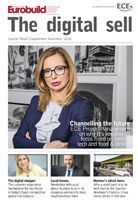Shopping in the sci-fi age
New technology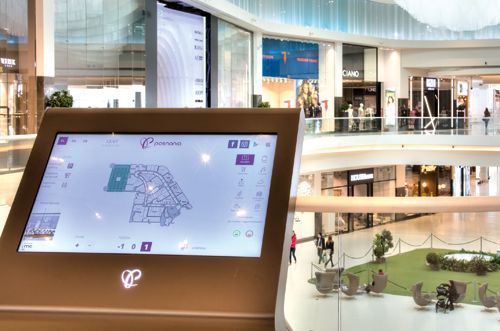
The footfall in shopping centres worldwide has been gradually shrinking. For the managers and owners of such buildings this has been a signal that changes are needed and that they have to adapt to consumers’ changing preferences. Modern technology, however, is coming to their aid and is now playing a decisive role in marketing strategies and tenant mixes by making them much more personalised. Furthermore, modern tech has been lending a hand to mall owners by automating many of their processes.
System that controls
Our shopping centres are becoming smarter by the day. They are being equipped with integrated systems that take care of the comfort of customers and employees as well as their safety and communication. They control the heating and lighting and turn on the air conditioning whenever needed. One such system is BMS, the ‘building management system’, which operates in such centres as Galeria Północna in Warsaw. “It’s a kind of computer, into which various types of data are constantly fed, making it possible to control all the processes taking place in the building,” explains Agnieszka Nowak, the director of Galeria Północna. Information is gathered constantly by more than 15,500 measurement points located throughout the building and includes such data as the temperature, the air flow, the humidity as well as the safety of the installations and valves located throughout the building. “Many of these parameters, such as the air quality and purity, have a direct impact on the well-being of people. With this constant control and optimisation, their stay with us is made as comfortable as possible,” claims Agnieszka Nowak. The building is also equipped with video monitoring, which processes information obtained from more than 300 cameras installed on the premises. When an irregularity occurs, it identifies the precise location of the incident to the person in the guardroom, reducing the reaction time needed. Meanwhile, the thermovision camera system independently ‘counts’ the number of customers.
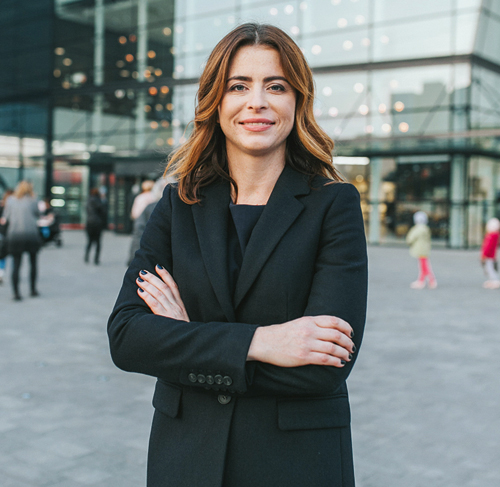
Agnieszka Nowak, the director of Galeria Północna
Galeria Północna is also equipped with a long-life LED lighting system. This is controlled by special software, enabling it to change colour and to operate in any chosen pattern. The lighting on the southern façade of Galeria Północna is activated by the customers – sensors in the pavement react to pressure and change the lighting under its influence. ”It’s a modern system that hasn’t been used in any retail centre in the capital city,” says Agnieszka Nowak.
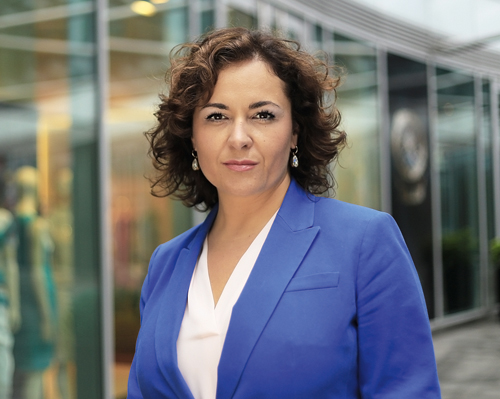
Marta Machus-Burek, a senior partner and the director of the retail department at Colliers International
Defining their needs
New technology is increasingly being harnessed to improve the requirements of today’s consumer. One tool, developed by CBRE’s London team, is especially useful in this respect. “This is Calibrate, which uses GPS data from mobile phones. It gives us the ability to identify where customers come from, how much time they spend in the building, and what other places they visit,” explains Magdalena Frątczak, the senior director and the head of retail at CBRE Poland.
With this system, the owners, managers and tenants of shopping centres can identify the preferences of their customers, which helps them in the preparation of marketing and sales strategies for individual locations. “It provides a precise definition of the customers in a variety of ways, including their demographic profile, the way they move through the shopping centre, the frequency of their visits, their shopping habits and where they live. It can also be used to draw up a comparison with other locations visited by consumers. With its help, we can determine how many customers come from abroad. If it turns out that, say, 30 pct of customers are German, this gives a signal to the owner of the building that information in this language needs to be provided,” points out Magdalena Frątczak. For now, interest in the tool is coming mainly from the owners of buildings that are already being used. It can be used to show how non-retail Sundays in Poland affect sales revenues or the effect of a rival centre opening nearby. This enables us to find out if a drop in the number of visitors is a one-off or a trend. Several buildings can also be selected to make a comparison. Other options include gauging the impact of a particular marketing campaign or the launch of a new brand on the increase in the number of visits to the centre. Calibrate not only helps to detect changes that have occurred in a given location but also to understand their causes. For instance, to find out which tenants attract customers the most.

Magdalena Frątczak, senior director and the head of retail at CBRE Poland
Getting closer to the customer
“Studying customers’ shopping habits is currently the most important task required by shopping centre managers. It has an influence on the further development of the project. New technology is also having a greater impact on the activities of developers, where it is being used as a tool in the leasing process and for marketing campaigns,” argues Łukasz Prażmo of Re-evolution, which provides IT systems for the real estate sector. This includes spatial analysis and 3D modelling for building management software.
One of the ways to obtain information about customers is through Wi-Fi networks – and these are increasingly being used by visitors of shopping centres. For their owners and managers, this has become a basic form of communication with customers and a source of knowledge about them. When registering for the network using a smartphone, customers agree to join it. They then gain access to all the latest information about brands, promotions and events. In exchange, the operator of the mall receives data that can be analysed to find out more about customer preferences. An individual customer profile can thus be created detailing their shopping habits, the time he or she spends in the mall, and the routes they cover. After a certain amount of such data has been received from meters at the entrances the to the mall and selected stores, the owner or manager can create what are known as heating or saturation maps that indicate which places in the mall are the ‘hottest’ and the ‘coldest’. The manager can also discover which areas of the centre are visited most often.
Priceless data
Today’s shopper, of course, carries a smartphone at all times. With these people in mind, special apps have been developed to inform visitors about current promotions etc. and which also use geo-location services to identify free parking spaces or the way to a chosen store. Customers can also receive information about the promotions offered by shops they are just passing. Such systems are used in Manufaktura in Łódź and Posnania in Poznań.
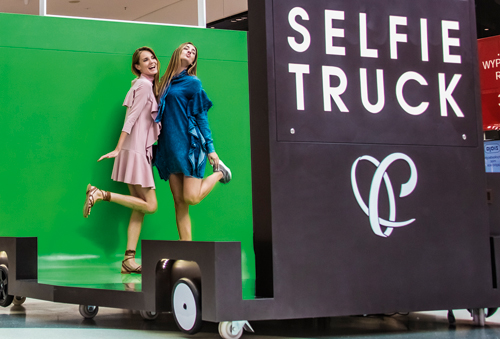
Posnania’s selfie truck
Visitors to the mall are also followed by a network of cameras, which constantly analyse the movement of cars and which parking spaces are available. This is done by sensors that read cars’ licence plates after they are parked. Thanks to this, customers do not have any problems finding their vehicles afterwards. In Galeria Północna they can be located using the info-kiosks at the entrance to the car park. Beacons are also now being used. This involves a system of small transmitters that receive signals from smartphones containing information about customers’ tastes, habits and behaviour. In this way tenants can be provided with a personalised offer that fits their individual expectations. “The owners and managers of shopping centres are thus given access to a vast amount of knowledge that can directly increase their income. Amazon Books and Alibaba opened stores last year based on data obtained from customers,” emphasises Łukasz Prażmo. In his opinion, such a mechanism for understanding consumers’ needs should be used in every retail centre in Poland. “By using big data analysis, our company noticed that there was an above-average number of people visiting the household sections of shopping centres in the south of Poland, greater than in other regions,” he reveals. This could be valuable information for toy or home accessories retailers, and, in fact, the owner of the shopping centre is currently directing its services towards such tenants.
“The combination of the Internet of Things with the power of big data and sensory technology is enabling centres to generate enormous data resources. This is extremely valuable information when it comes to making business decisions, but it also poses a significant challenge in terms of its filtering and processing,” points out Marta Machus-Burek, a senior partner and the director of the retail department at Colliers International. In her opinion, new technology will be the foundation for the development, management and maintenance of shopping centres in the next five years. The owners of such buildings are set to keep on introducing it, which will make it possible to integrate brick-and-mortar retail with the digital world, creating a single, cohesive ecosystem.
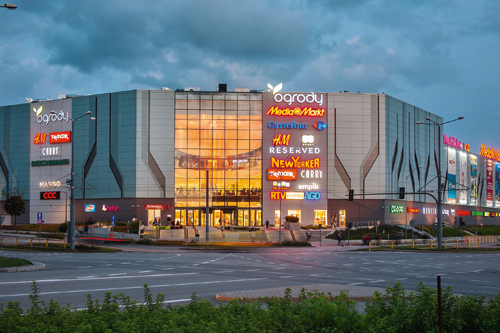
The Ogrody shopping centre in Elbląg
Black boxes
Apsys Polska has been introducing the BlackBox Intelligence System (BIS) developed by Polish company IPP to manage the leasing in the centres it manages. The system monitors the transaction process for all the tenants of a building, automatically downloading data and providing reports on the turnover of individual stores. The information includes such detailed data as: the number and value of transactions of individual retail outlets as well as the sum of transactions broken down into categories of goods. It also includes the location of the store in the mall and divides purchases into segments and the time they were made. As a result it can give insights into sales trends and changes in customer behaviour. The system is now being used in Posnania. “It is a very effective tool for the centre’s managers. It supports the management of retail space and decision making in terms of locations for new tenants,” claims Agnieszka Tomczak-Tuzińska. It is also useful when it comes to devising advertising campaigns for the mall and preparing a personalised offer for costumers.
Omni-channel in practice
The technological revolution has resulted in shopping centres becoming places where various sales channels converge into the most effective sales model: omni-channel. “This approach is increasingly visible in shopping centres, as it can help them to establish a competitive advantage. Furthermore, the tenants themselves are investing in this by changing their brick-and-mortar stores into integrated customer contact channels. And so they are also places where the consumer experience is being enhanced,” notes Marta Machus-Burek. One example of this is ‘click & collect’ services, a service which many retailers are embracing. This allows you to order a product in an online store or by using an app and then pick it up in a brick-and-mortar store. Click & collect services are currently used in shopping centres by such brands as Zara and Mango. In addition to that, this service is also being introduced by the shopping centres themselves, including Posnania and Ogrody in Elbląg. Customers of these malls can immediately try on the clothes they have ordered in a special zone in the centre. If they then decide to return them, all the formalities can be carried out by the staff.
Personalisation to become the norm
What will the shopping centres of the future be like? According to CBRE, artificial intelligence could constitute as much as 85 pct of the customer service process. Devices such as interactive screens displaying a store’s products, tablet shopping and virtual fitting rooms are among those being introduced to attract customers. The Internet of Things is also likely to play major role, for instance, in reporting when a store is out of a certain product is out of stock and it needs to be restocked.
“Customers today expect a personalised approach, services and products – but this is nothing new. The new thing is that they are ready to share their data. By 2030, instant and personalised offers will be the standard. Technology such as RFID [radio-frequency identification], smart wearables, biometrics, digital displays and sensors will all be commonplace,” predicts Marta Machus-Burek. ν























